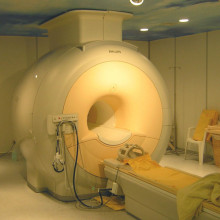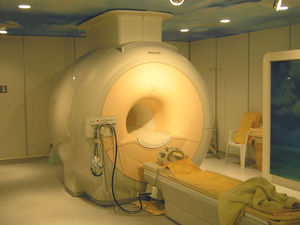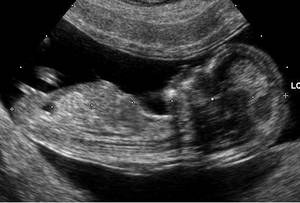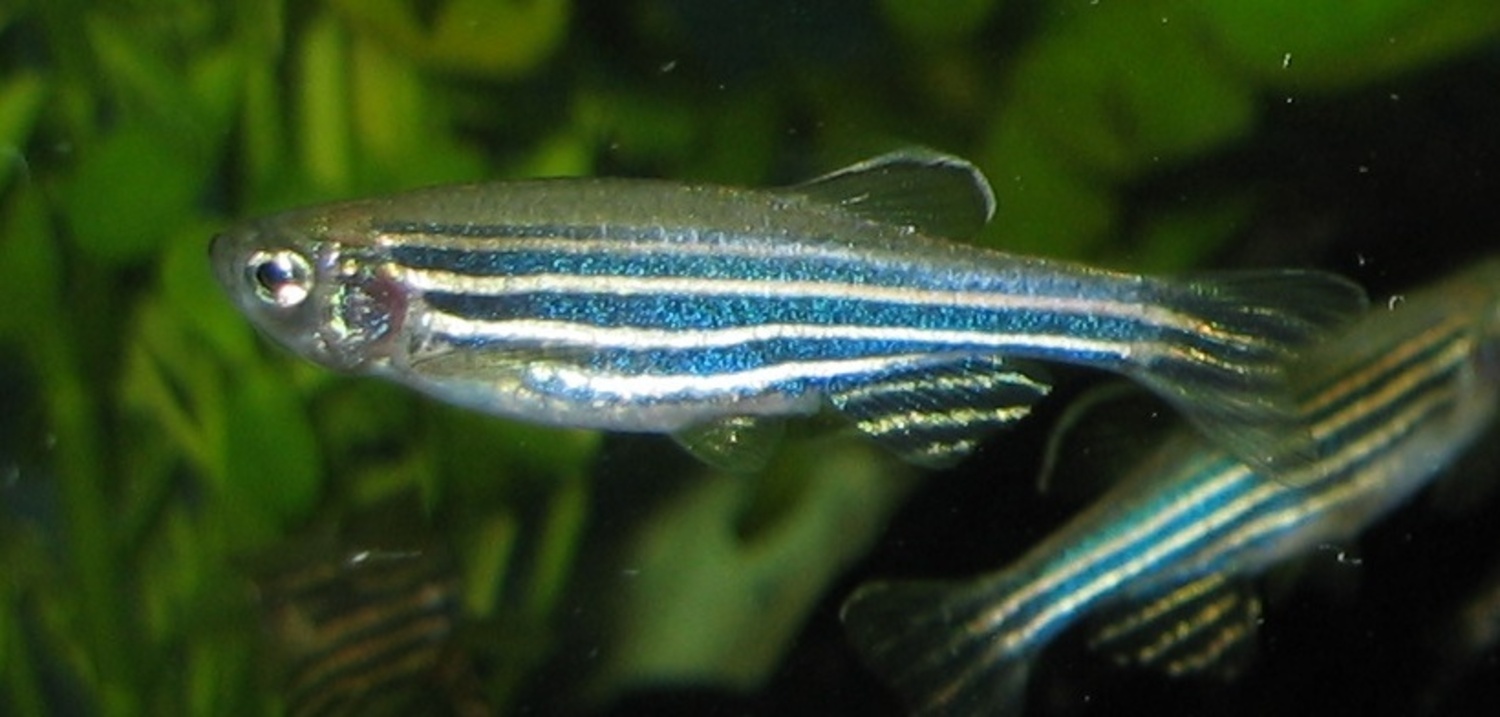Resurrected Plants & Nutrition in the Womb
In this newsflash, we discover the micro MRI machine that can probe individual atoms, find out why brain training computer games may help sufferers of schizophrenia, and how Russian researchers have resurrected a 30,000 year old plant. Plus, how nutrients in a mother's diet can alter gene expression in her baby and a roundup of other science headlines...
In this episode

Micro MRI
By measuring how atoms oscillate in a magnetic field we have learnt a huge amount of chemistry using nuclear magnetic resonance machines, and they have been adapted to form Magnetic Resonance Imaging machines which are the MRI machines that allow doctors to study the soft parts of the body by using the way atoms oscillate to measure the magnetic field they are sitting in. These are incredibly useful because the electrons around the atom and even the electrons in the neighbouring atoms can affect this. This information is very useful, but the smallest object you can distinguish is about a mm.
in. These are incredibly useful because the electrons around the atom and even the electrons in the neighbouring atoms can affect this. This information is very useful, but the smallest object you can distinguish is about a mm.
Shimon Kolkowitz from Harvard, and colleagues are aiming for something better. Rather than using at atom as a magnetic resonator, to measure the magnetic field, they have used a mechanical resonator - effectively a microscopic tuning fork - with a tiny magnet on the end. they mounted it on a magnetic force microscope, which scans the resonator across a surface with a sub-atomic precision.
The local magnetic field will affect the vibration of the resonator which can be measured and if it comes near an atom which is vibrating at a similar frequency the interaction gets even stronger. They have used this machine to measure magnetic interactions with a single nitrogen atom in diamond, and they have even used the mechanical oscillator to affect the state of the atom and alter how it interacts with light.
This is still a very experimental machine, but they suggest it could be developed into a way of measuring and writing the state of a single quantum mechanical system, which would be useful for quantum computing, or possibly even into an MRI which would be able to see individual atoms on the outside of a molecule, and tell you what they were, and what state they are in.
02:42 - Gaming away the symptoms of Schizophrenia
Gaming away the symptoms of Schizophrenia
Using certain computer games can improve the symptoms of schizophrenia and produce long-lasting benefits for patients, a new study has revealed this week.
Schizophrenia affects 1% of the population, or 70 million sufferers worldwide.
People with the condition develop hallucinations, hearing sounds and voices that aren't really there and seeing things that don't exist in reality. They also develop delusions - which are false ideas - to help them come to terms with these strange experiences. Together these effects can destroy a person's quality of life, and their relationships with others.
But now a team at the University of California, San Francisco led by Karuna Subramaniam have found  that using specially-written computer games that rely heavily on memory and also require players to intensively process auditory and visual information, including interpreting facial expressions, can produce significant improvements in the player's symptoms.
that using specially-written computer games that rely heavily on memory and also require players to intensively process auditory and visual information, including interpreting facial expressions, can produce significant improvements in the player's symptoms.
The researchers compared a group of 31 schizophrenics and 16 healthy "control" individuals over a 16 week period. After a baseline brain scan of all the individuals, the schizophrenics were split randomly into two roughly equal groups, one of which played commercial computer games and the other spent the same amount of time - 80 hours - using the brain-training software built by the researchers.
At the end of study, the participants were re-assessed using a range of behavioural and scanning-based methods.
Compared with the individuals who played the commercial computer games, those that received the brain-training treatment showed a significant improvement in their accuracy of information recall. This was mirrored by improved social functioning and an increase in activity in a brain region called the medial pre-frontal cortex, which is concerned with planning and decision making.
I spoke to study co-author Sophia Vinogradov about the implications of their findings...
These findings may have far-reaching implications for improving the quality of life for patients suffering from neuropsychiatric illness, not just from schizophrenia but also other disorders defined by cognitive deficits including autism and obsessive control disorder".
Sophia Vinogradov, who published that study this week in the journal Neuron.

07:53 - Eating and Epigenetics - How maternal nutrition alters gene expression
Eating and Epigenetics - How maternal nutrition alters gene expression
Professor Nabeel Affara, Cambridge University
Chris - It's well known that what you eat, drink or smoke during pregnancy can have long term consequences on the developing foetus. But now, researchers at Cambridge University have identified how a mother's diet before she becomes pregnant can lead to genetic changes that last well beyond birth. To find out more, we're joined by Professor Nabeel Affara...
Nabeel - This study is really a collaboration between us in the Department of Pathology and Professor David Dunger in the Department of Paediatrics, together with Professor Andrew Prentice at the London School of Hygiene and Tropical Medicine who heads up the MRC International Nutrition Unit. It's a study that's based in the Gambia where, in rural Gambia, there is a chronic shortage of food. Superimposed upon that, you've got a seasonal variation in the food supply because the food that they eat is grown in the wet season, that is called the hungry season, and that then is harvested in the dry season, and that's when food is plentiful.
Chris - So you've got this nice natural variation in people being relatively well fed and relatively less well fed.
Nabeel - That's right.
Chris - So, you can compare the two.
Nabeel - Exactly.
Chris - And so, what did you actually do with those people?
Nabeel - What has been observed here is that with this seasonality, there is an impact on the incidents of infectious disease and mortality amongst young adults. Those born in the wet season die much more at a much younger age and have a much higher burden of infectious disease. So we wanted to ask the question whether exposures early in pregnancy or even at what we call the peri-conceptional period, that is before a woman becomes pregnant until  the time that pregnancy is confirmed, whether supplementation of the diet, particularly for known deficiencies in micronutrients, has an impact on this disease burden.
the time that pregnancy is confirmed, whether supplementation of the diet, particularly for known deficiencies in micronutrients, has an impact on this disease burden.
Chris - So there could be two effects going on, one could a genetic effect because of the woman becoming deficient in something before or around the time she gets pregnant and that could have a genetic legacy effect on the baby. The other is that the baby could just be exposed to an environment in which it's eating a relatively impoverished diet, and that makes it more prone to getting things down the line.
Nabeel - That's correct. So, what we wanted to ask is whether the offspring of women who received the supplementation compared to women who received a placebo - that is exactly the same pill but without the cocktail of minerals and micronutrients - whether when we examined the DNA of the offspring of these women, there was any difference in the epigenetic state. What's important to understand here is that we're not actually looking for changes in the DNA sequence, but actually changes, modifications to the DNA that affect the activity of genes.
Chris - This is where you get chemical markers, methyl groups, stuck onto the sides of genes that affect how well they get turned on or off. They're like a dimmer switch for genes, aren't they?
Nabeel - Exactly. And methylation, as the process is called, is adding a methyl group onto cytosine, one of the DNA bases. This can affect the activity of the gene, but it's one of many epigenetic changes that can take place that modulate the activity of genes. What appears to be the case is that once a state is set, this can be a long term state that may last for the life of the individual.
Chris - So you got these groups of women, recruited them into the study, randomized them to get either the placebo or the vitamin pills. How did you then follow up the offspring?
Nabeel - We took blood at two stages, one at birth from cord blood - therefore, that is blood from the baby at term - and extracted DNA from that. We then followed that up with peripheral blood from some of the same children at 9 months of age. We then ran an assay that measures the state of methylation of all genes across the human genome. We were be able to do this on a DNA chip called a methylation chip. Essentially, it allows you to compare the two states and ask whether there's a difference between the offspring whose mothers receive the supplementation and those whose mothers did not receive the supplementation.
Chris - And what did you find?
Nabeel - What we found was that the supplementation given over an 8-week period, right at the beginning of the pregnancy and before their pregnancy, had an impact at term and that there was a difference in a relatively small number of genes in the newborn. Then, at 9 months, we found many more changes as well. So, in a sense, there's a sort of programming going on early on and early exposure is programming the genome to have a certain pattern of activity.
 Chris - At this stage you only know that those genes changed their pattern. You don't know how that affects the expression, the amount of the genes that get made.
Chris - At this stage you only know that those genes changed their pattern. You don't know how that affects the expression, the amount of the genes that get made.
Nabeel - Exactly.
Chris - But, those genes presumably will give you enormous insights. There's a lot of avenues to follow now to ask, well, what do they do and how do they affect the health outcomes for these children?
Nabeel - You've hit the button there in that this work has identified candidates that might be influencing important aspects of their physiology and may give us insights into the pathology that these individuals suffer from. We need to go on and investigate precisely what those changes mean in terms of the activity of these genes.
Chris - To finish up, this is in individuals who are relatively impoverished in terms of their dietary intakes...
Nabeel - Yes.
Chris - What are the implications for people who are eating a relatively good diet? Does this nonetheless say, "Well, be careful because if you have micronutrient deficiencies, there may be implications even if you think you're eating a good diet."
Nabeel - This is highly relevant to our own society where food security is more assured, but overeating, exposures to, for example, excessive carbohydrate, we know can bring about similar epigenetic changes and may also impact on health at a later stage in life. Diabetes, for example, is a very good case in point. At the present time, we're suffering an epidemic of diabetes. So, it is important even in societies where there is an abundant food supply. The appropriate balance of nutrients is the key thing here for normal development.

14:48 - Meat in the Lab, Not-so-speedy Neutrinos, Tracking Toxins and Fearful Fish!
Meat in the Lab, Not-so-speedy Neutrinos, Tracking Toxins and Fearful Fish!
Mark Post, Maastricht University; Alfons Weber, RAL; Rongsheng Jin, Sanford-Burnham Medical Research Institute; Suresh Jesuthasan, National University of Singapore
Man-Made Meat
The first lab grown meat is being cooked up by scientists at Maastricht University.
University.
Presenting at the AAAS science meeting in Vancouver this week, Mark Post used stem cells from cows to grow strips of muscle tissue 2cm in length. By combining 3000 of these with strips of fat tissue also from stem cells he hopes make enough minced meet to make a quarter pound hamburger.
If proven to be feasible, the technique could alleviate the environmental burdens of current meat farming practices.
Mark - The way meat is produced today has lots of problems. Livestock emits lots of greenhouse gases. They of course use lots of land and lots of food. One of the biggest problems is that, in the coming 30 years, we will not have enough meat to feed the world population. So the idea here is that in the lab, you have much more variables under control and you can make this process more efficient and therefore, using the same resources, you can make much more meat.
---
Neutrinos may not have been Faster than Light
Recent claims of neutrinos travelling faster than the speed of light as part of the
OPERA experiment may have been due to problems with equipment.
In September neutrinos were observed to be travelling 0.0025% faster than the speed of light between the CERN facility in Geneva and Gran Sasso Laboratory, 732 km away in Italy.
The team behind the experiment have since been checking how these potentially revolutionary results could have occurred and have now identified some flaws, as Alfons Weber from the Rutherford Appleton Laboratory comments.
Alfons - They found two effects. One of them is that there was a loose optical connection that carries the GPS timing signal underground and then there was another effect where one of the clocks they were using, or frequency counters, somehow their correction was different from what they originally saw. One of these effects could make the apparent travel time of the neutrinos longer and the other one shorter and it's not clear which effect would dominate but they will affect the measurement. This newest information puts very much in doubt that they're the real effect.
---
Watching Toxins Travel
The tricks used by
botulinum neurotoxins to protect themselves as they move through the human body have been revealed by scientists at the Sanford-Burnham Medical Research Institute.
Although commonly used as a cosmetic due its ability to paralyse muscle, this poisonous toxin can cause severe illness and paralysis if inhaled or ingested. Using X-Ray crystallography , Rongsheng Jin identified the presence of a bodyguard protein which binds to and protects the toxin as it passes through the harsh environment of the gut, then breaks free allowing the toxin to enter the bloodstream.
Rongsheng - We now want to develop small molecules which can mimic the signal which trigger the disassociation of the toxin and its bodyguard. They will break up this toxin-bodyguard complex in stomach. Then we can use our own defence system in a stomach, like low pH and digestive proteins, to kill the toxin before it could even penetrate the intestine. And by doing so, we will have a new strategy to fight these toxins.
---
The Sweet Smell of Fear
And finally, it seems the smell of fear is sweet - well for fish anyway.
When fish such as zebrafish are injured, they're known to release chemicals signalling for th e rest of their shoal to escape in fear.
e rest of their shoal to escape in fear.
Suresh Jesuthasan and colleagues from the National University of Singapore have now found the crucial component of this signal to be the sugar, chondroitin sulphate, found in fish skin. It's thought the sugar is broken down by enzymes activated during injury releasing the sugar fragments into the surrounding environment...
Suresh - When the chondroitin sulphate fragments are released, they bind to the olfactory sensory neurons in the other fish which then triggers a signal to the olfactory bulb and this subsequently activates various fear centres within the brain. There's one very curious aspect about the alarm response which is that it's concentration dependent. So if you have a little bit of it you have a mild fear response and if we have a lot, you have a strong fear response. This is very unusual for any odorant, so this is a good way to see how you can induce different fear states.
The paper is published this week in the journal Current Biology.










Comments
Add a comment